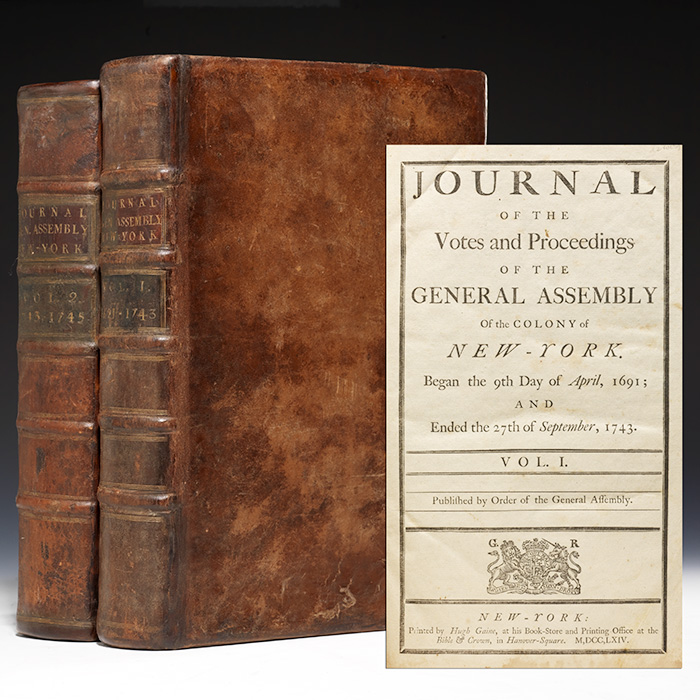
INSCRIBED BY JAMES FENIMORE COOPER, AN EXCEPTIONAL FAMILY COPY OF THE SCARCE FIRST EDITIONS OF THE JOURNALS OF THE NEW-YORK ASSEMBLY, “CORNERSTONE OF NEW YORK AND AMERICAN COLONIAL HISTORY,” ADDITIONALLY INSCRIBED BY COOPER’S BROTHERS, SON AND GRANDSON
(COOPER, James Fenimore) (NEW YORK). Journal of the Votes and Proceedings of the General Assembly of the Colony of New-York. Began the 9th Day of April, 1691; and Ended the 27th of September, 1743. WITH: Journal of the Votes and Proceedings of the General Assembly of the Colony of New-York. Began the 8th Day of November, 1743; and Ended the 23rd of December, 1765. New York: Hugh Gaine, 1764, 1766. Two volumes. Thick folio, contemporary full brown sheep rebacked with original spine and red and black labels laid down, raised bands. $6800.
First edition of this “cornerstone of New York and American colonial history,” an exceptional association copy inscribed by James Fenimore Cooper and dated by him: “May 1845,” additionally inscribed by his brothers, son and grandson. This first edition of the Journals represents the first collected publication of the New York Assembly’s landmark petitions against the Sugar Act, claiming the right “to secure that great Badge of English Liberty, of being taxed only with our own Consent.”
This outstanding association copy of the pre-Revolutionary Journals of the New York General Assembly was in the Cooper family for decades before being received by James Fenimore Cooper in 1845. Featuring a remarkable series of familial inscriptions in both volumes, these Journals were given to Cooper by his brother, then passed along to the author’s son and grandson. A writer who “consistently stressed the significance of American politics and culture” and reflected this passion in both his fiction and many histories, Cooper “secured his place as the first true American novelist” with his third novel The Pioneers (1823), which featured the character Major Hartman, modeled after Hendrick Frey, the family friend who first presented these Journals to Cooper’s brother Richard in 1812 (Introduction, American Democrat).
In addition to this extraordinary provenance, the Journals represent the first printing of the “most important legal collection of its time, and a cornerstone of New York and American colonial history” (Jenkins). Covering the proceedings of the first permanent Assembly of the New York colony from its initial meeting on April 9, 1691 through December 23, 1765, the Journals were invaluable to Cooper’s work, for he systematically consulted “authentic publick records, private documents, more especially those in possession of the Cooper family” (Chronicles of Coopertown, 3). Significantly this pre-Revolutionary chronicle also provides a detailed “constitutional history of New York” (Marke 80), especially the Assembly’s role in leading the movement toward independence. Of special note are accounts of the Assembly’s heated dispute with the Crown on the judiciary, its resistance to the Currency and Sugar Acts, and its bold assertion of September 11, 1764, in which the Assembly asserted its right “to secure that great Badge of English Liberty, of being taxed only with our own Consent… and also in pointing out to the Ministry, the many Mischiefs arising from the Act, commonly called, the Sugar Act” (II:749-50, italics in text). That frank objection emerged again in petitions introduced over the coming months—such as that of October 18, in which the Assembly claimed the right to “an Exemption from the Burthen of all Taxes not granted by themselves,” and in one voice warned of “tragical Consequences” should Parliament continue in “divesting us of the Right to tax ourselves” (II:776-7).
As such, the Journals’ petitions for the “right not to be taxed for revenue by Parliament are among the great state papers of the pre-Revolutionary period” (Knollenberg, 189). Edited by Abraham Lott, “this is the largest issue from Gaine’s Press, as well as the first piece of government printing he secured” (Benedict 368). The present copy includes the last leaf, an Appendix reversing the attainder of Jacob Leisler and others, “who were executed for not delivering the Fort at New York to Richard Ingoldsby, 1690” (Sabin); according to Evans, this last leaf is “often lacking.” With wood-engraved head-and tailpieces throughout. Contemporary annotation (I:427). Benedict 368. Evans 9756, 10418. Jenkins 175 (Volume I). Sabin 53719. OCLC lists 44 copies. This unique copy was presented to the family of James Fenimore Cooper in 1812 by the first representative to the colony's provincial legislature, Hendrick Frey, “a warm personal and political friend of Judge Cooper,” the author’s father (Beard I:27). Frey became the model for Major Hartman in Fenimore Cooper’s The Pioneers (1823). Both volumes contain an inscribed record of their passage through generations, and Volume II notably features Fenimore Cooper’s own inscription dated May 1845. The inscription leaf in the first volume opens with Frey’s inscription to Fenimore Cooper's oldest brother: “Richard F. Cooper, Esq. Presented by his sincere Friend Hendrick Frey, June 1812.” This is followed by an inscription by another brother, “Now the property of Isaac Cooper June 1813,” then by that of the author's son, “now the property of Paul F. Cooper who got it on the decease of J. Fenimore Cooper Sept. 1851,” and the inscription of the author's grandson, “Now the property of James Fenimore Cooper who received it from his Father Feby 23, 1891.” The inscription leaf in the second volume opens, once again, with “Richard F. Cooper Esq. presented by his sincere Friend Hendrick Frey June 1812,” followed by “Now The Property of Isaac Cooper June—1813.” This is succeeded by James Fenimore Cooper’s own inscription: “Now the property of J. Fenimore Cooper, May 1845.” This is followed by the inscriptions of the author’s son, “Now the property of Paul F. Cooper Dec. 2d 1876,” and the author’s grandson, “Now the property of James Fenimore Cooper presented by Paul Fenimore Cooper Feby 28, 1891.” Volume I inscribed below Abraham Lott’s Preface, “bound by Rob. McAlpine.”
Light foxing and dampstaining. Expert restoration to contemporary sheep and labels.